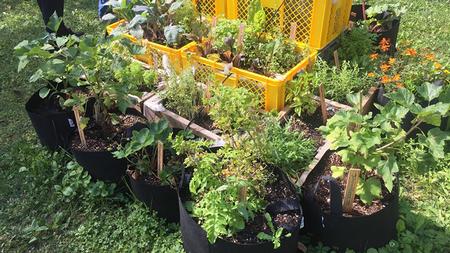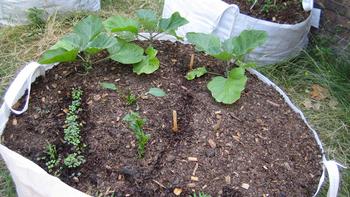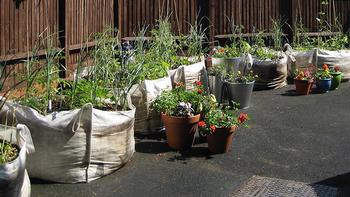News from the Edible Demo Garden
February 2023: Growing Veggies in Bags

What are Grow Bags?
Grow bags are fabric bags designed to hold water and soil. They are constructed from nonwoven felt type fabric made from natural and synthetic fibers. Grow bags intended for edible plants should be BPA-free and food safe. Increasingly popular for starting gardens or adding space to existing gardens, grow bags are available in a range of sizes and shapes. Some are designed for specific types of plants such as those for potatoes with a flap near the bottom to allow an easy harvest. There are also grow bags with self-watering systems. Most grow bags come with sturdy handles making them easy to move around.
 Garden space for starting new plants can be increased by using grow bags. Photo: Gordon Joly, Flickr
How to Use Grow Bags
Garden space for starting new plants can be increased by using grow bags. Photo: Gordon Joly, Flickr
How to Use Grow Bags

Plants that grow well in containers are the best choices for grow bags. The size of the bag determines the number and types of plants that can be accommodated. Most annual edible plants can be easily grown in 10-to-15-gallon bags. Smaller bags can be used for herbs and greens but would be too small for tomatoes. Larger bags provide more space but can be too heavy to relocate.
Grow bags should be filled with a potting soil mixture rather than garden soil. Garden soil can become compacted. Good mixtures contain peat or coir and perlite or vermiculite to retain moisture while allowing sufficient drainage. Compost and supplemental fertilizers can be added to promote plant growth. Grow bags can be placed directly on ground or pavement, however there will be leakage so a saucer underneath can prevent staining on decks or patios. Construction pallets work well to keep bags off the ground when invading roots from other plants might be a problem.
When the growing season is over, the soil can be emptied into the garden or compost pile and the bag cleaned and stored. With new soil added each season, there is less risk of built-up soil pathogens. Grow bags usually last for several seasons before they begin to deteriorate and need to be replaced.
 It’s possible to garden almost anywhere using grow bags if sun and water are available. Photo: Louise Joly, Flickr
Grow Bag Advantages
It’s possible to garden almost anywhere using grow bags if sun and water are available. Photo: Louise Joly, Flickr
Grow Bag Advantages

- Healthier roots – Because the fabric bags are breathable, roots are less likely to become root bound. When roots reach the air and drier soil at the edge of the bag, they stop growing in that direction. It’s a process known as “air pruning”.
- Excellent drainage – The porous bag fabric enables water movement and prevents problems due to overwatering.
- Location options – Grow bags can be put anywhere and moved as needed to take advantage of sun and shade. They are an inexpensive way to expand garden space and productivity.
- Heat control – Grow bags don’t get as hot in the summer sun as plastic or metal containers decreasing the risk of heat damage to roots.
Grow Bag Disadvantages
- Increased water needs – Because the soil drains well, it also dries out faster, so more frequent watering is required.
- Heavy bags – Larger bags can be challenging to move around easily reducing options for relocating them during weather changes.
- Appearance – Grow bags can be considered less aesthetically pleasing than other types of containers
- Need for replacement – Grow bags need to be replaced periodically as they don’t last as long as containers made of other materials..
- Environmental concerns – Some grow bags contain polypropylene or polyethylene fibers making them non-biodegradable.
Although grow bags may seem like a new idea, centuries ago the ancient Egyptians and the early Greeks were growing plants in woven containers.
For tips about growing edibles in containers, check this website at https://marinmg.ucanr.edu/EDIBLES/ContainerEdibles.
